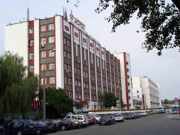Brest Railway Station
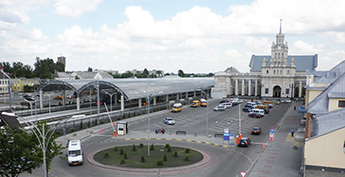
The square in front of the main station building after the renovation of 2014. A virtual walk around the station.
There are two sides of the station due to a break-of-gauge. The Warsaw side is seen on the Left. The trains to Poland depart from that side. On the right the Moscow side is seen. The line of 5-foot Russian track gauge 1,520 mm meets a line of 1,435 mm Standard gauge at the station. Near the main station building there is a special site for bogie exchange of passenger trains. In 2015 a variable gauge system was commissioned in Brest. The Russian Railways acquired from Talgo, Spain, passenger carriages with trucks equipped with a variable gauge axle (VGA). A site with a Spanish Talgo-RD changer is now in Brest.
Historic background
Traffic on the Brest-Moscow railway began on November 28, 1871. 2 years prior to this event, a railway had linked Brest with Warsaw. Thus, Brest became an important station at a transcontinental railroad linking Moscow with Paris. The railroad and the station gave an impetus to the city's fast development and industrial boom.The first railway station was located in Brest at the north ends of Kuybyshev St. and Karbyshev St. Today it is the premises of Gefest Plant. Mr. Ludvig Strashevich was the first station-master from 1870 till 1885 in Brest.
The architect Boris Lorberg (1825—1888) from St.Petersburg proposed the design of the new station building in the Neo-Russian style. On June 21,1884, the design was officially endorsed. The construction of the new station lasted for two years, from 1883 to 1885. It cost the Russian empire nearly 2 million rubles.
.
On May 28, 1886, the first passengers entered the new station. In summer 1886, Alexander III, the Russian emperor, inspected military maneuvers not far from Brest, he wanted to see the first airships that appeared in the Russian army in 1885. Being in Brest, he welcomed the German crown prince, the future German emperor William II, onto the platform of the new station and carried out the opening ceremony of the station. In the late 19th century, it was the biggest and most beautiful station building in Russia, a new western gateway to Russia. It had richly decorated halls, restaurants to pamper the passengers from abroad. In those days, passenger trains had carriages of 4 classes, that were painted as follows, 1st class blue, 2nd class auroauric, 3d class green, 4th class gray. This was the first station in Russia to have electric lights installed.

The Warsaw express arrived.
A photo of the early 1900s.

The southern side of the station in the early 1900s.
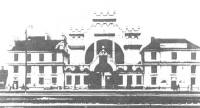
A view of the station after it was rebuilt by Polish authorities in the 1930s.
During WW1 the station was badly damaged. The roof of the central waiting hall collapsed, walls were damaged as well. In the 1930s during the reconstruction the central waiting hall became larger thanks to a new tall ceiling. The central tower over the main entrance became taller, acquiring another floor atop. Now it was projecting in the direction of the square. The station suffered the worst damages in 1941 during WW2. It saw fierce fighting, gunfire and bombardment. The passengers repelled numerous attacks of Nazi assaulting groups in the opening hours of the war, that broke out on June 22, 1941. On July 28, 1944, the city was liberated by the Red Army. On July 31, 1944, the first trains were driving between Brest and Baranovichi. In the late 1940s the station building was renovated. In 1953-57, the building was reconstructed, to welcome the numerous guests, coming to the World Festival of Youth and Students in Moscow, in 1957. The entire complex regained its classic view that was proposed by the architect U. Pestrakov. The walls of the central waiting hall were clad with various kinds of marble, classically decorated with semi-columns and Corinthian capitals. On December 31,1975, a new waiting hall in a modern style was commissioned between the main building and the building of ticket offices. It was dismantled in 2013. In 1993, the renovation, carried out by Polish builders, refreshed the building without changing its architectural style. The project's cost totaled $1,063,000. In 2012-2014, the station underwent a renovation.
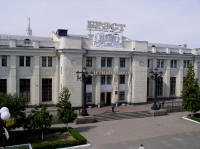
The building of the ticket office.
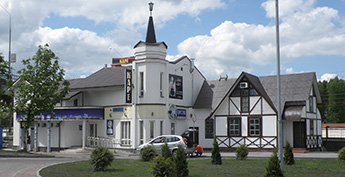
An office building by the car parking.
More about the station:
in Wikipedea

